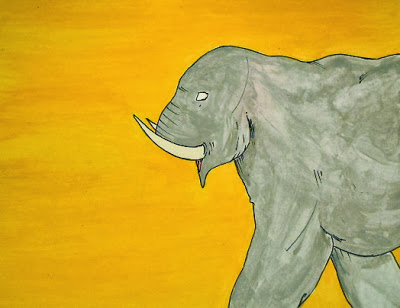This was inspired by an elephant card I came across yesterday while looking for trading card designs. My first thought when I saw it on eBay was, "I want that!" Then, "I'll make that!"
The original is quite nice, and I may still buy it before the time is up, but if you're interested, you can find it here.
 |
| Novelty card produced for the Harlfinger Baking Company, Albany, N.Y. Source: http://www.ebay.com/itm/Elephant- paper-doll-trade-card-Albany-NY-bread- /231004556575 |
With visions of misaligned and ill-fitting tabs and slits dancing in my head, I sketched out an elephant on artist-quality bristol board. I sketched the whole elephant to start with, thinking that might help.
Before committing anything to ink, I figured out where the curved slits needed to be, and sketched them in. Next, I taped the original elephant sketch to a window, taped another piece of bristol board over top, and traced over the elephant again, again marking the slits. I figured this might help me when I went to make the mechanical part.
Given my lack of paper engineering skills, I decided I ought to test this design to see if it worked. I traced both parts onto scrap bond paper. Testing was a very good idea, because I discovered that the original design is unworkable. For the mechanics to function, the slits all have to curve in the same general direction. As you can see in the closeup of the ear, I had to cut, tape and recut several times before I got it to work at all.
Once I had everything figured out, I went back to my bristol board version and outlined everything with a permanent pigment liner. To make sure it wouldn't run when I painted it, I heat-set it with a hairdryer. I gave the mechanical part two eyes, figuring that this area would slide enough that I'd need two eyes to avoid having a periodically blind elephant.
To give it the look of an early-twentieth-century piece, I decided to paint it with gouache.
After the paint dried, I went back over some of the lines to give it the graphic look of the card that inspired me.
I cut the mechanical part out, and sliced the curved slits with a sharp craft knife. The original also has a cutout for the eye. Once everything was cut, I slid the moving portion through the little slits. The ear was a bit of a challenge because I had made the ear a bit too wide for the slit, but I managed to squeeze it through with some almost-gentle persuasion.
I was very happy with the way it looked, but it didn't really do much. For it to astonish and amaze, it probably would need much longer slits, and they would all have to be curved exactly the same. Things kept sticking around the tusk, for example. However, I know next to nothing about paper mechanics, so don't take my word for it.
For better or worse, here it is in action. I also discovered that, if I tugged on the tab instead of sliding it back and forth, I could make the ears flap and the trunk lift. I also discovered that the ear-flapping effect worked much better with my paper version than the one made of bristol board.
In the end, I liked the way it looked, but wasn't overly impressed with its mechanics. The mechanics also took me a stupidly long time to figure out and fiddle with, which tends to make me a little cranky. That said, it's pretty enough that I'll keep it, but not fun enough that I'll rush to make another one.
Elephant Lore of the Day
In the video I made a few days ago, there was a pair of photos relating to one of the most unusual and touching stories I've ever read about elephants. These were the photos:The man in the first photograph is Lawrence Anthony. A longtime champion of wildlife, Anthony was also known as the "Elephant Whisperer" for his ability to rehabilitate elephants with severe behavioural problems—elephants who would otherwise be put to death. With him is Nana, a former rogue elephant who became matriarch of the herd at Thula Thula Private Game Reserve in South Africa.
The second photograph shows one of the Thula Thula herds, unexpectedly arriving at Anthony's house following his death in March 2012. In what appeared to be a tribute to Anthony, both of Thula Thula's elephant herds began arriving en masse within two days of his death.
As I wrote in my original Elephant a Day blog, the herds were at least 12 hours away when he died. According to Anthony's son Dylan, the elephants hadn't been to the house in 18 months, making their trek even more unusual.
Arriving within a day of one another, the herds remained quietly around the house for two days, then headed back into the bush.
It is not known why the elephants made the trek. Perhaps they missed seeing Anthony out in the bush, and came looking for him—although this was something they'd never done before. Or perhaps Anthony's family and friends were right in thinking that somehow the elephants knew he was gone, and came to pay their last respects, as they often do with their own kind.
To read more about Lawrence Anthony and the elephants of Thula Thula, click here.
To Support Elephant Welfare
Boon Lott's Elephant Sanctuary (Thailand)Wildlife SOS (India)
The Elephant Sanctuary (Tennessee)
David Shepherd Wildlife Foundation


















No comments:
Post a Comment